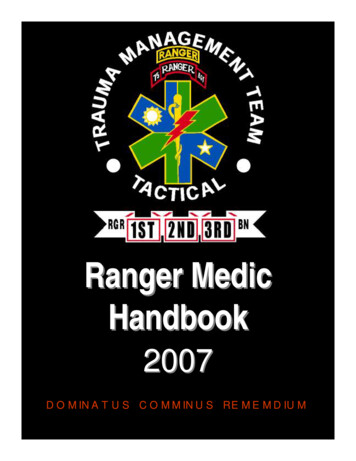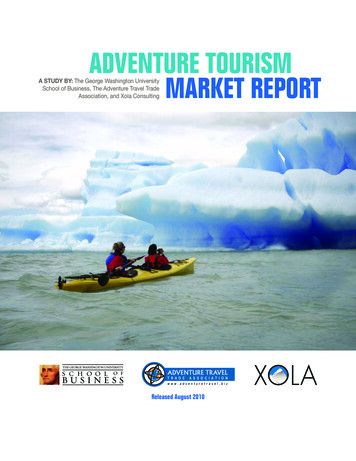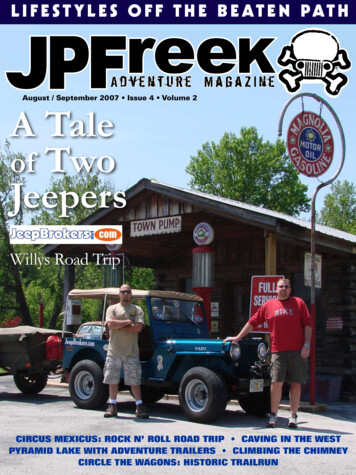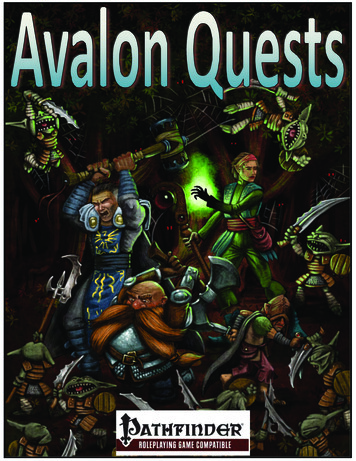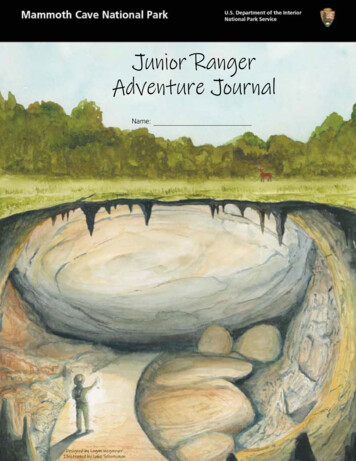
Transcription
Junior RangerAdventure JournalName:Designed by Logan WegmeyerIllustrated by Luke Schutzman
Become A Mammoth CaveJunior RangerIn order to become a Mammoth Cave Junior Rangeryou must complete three tasks.1. Complete the number of activity pages foryour age range. Every Junior Ranger must completethe activity page “Getting Started”.Ages 4-7Must complete 6 activity pagesAges 8-12Must complete 8 activity pagesAges 13 Must complete 10 activity pages2. Go on at least one cave tour, attend a ranger-led program or hike through thewoods. Hint - The activities “Snapshot”, “Scavenge For Answers”, “Citizen Science”,and “Follow Me!” are made for hikes through the woods.3. Once you have finished your first two tasks, get your book checked by aranger in the visitor center and receive your Junior Ranger badge and signedcertificate.Special thanks to:Show us how your adventure hereat the park went on social media anduse the hashtag#MammothCaveJR
Getting StartedWelcome to Mammoth Cave National Park, the longest known cave system in the world!We are excited you have come to explore this special and diverse park. There is so muchto learn, above and below ground. Be sure you go on a cave tour or hike through theforest. There is an adventure here for everyone.This journal can be a tool for your adventure at Mammoth Cave. Write down how yourvisit went at the National Park. Explain how the park is similar to where you live, andhow it is different.My Adventure at Mammoth CaveDate I was here:What the weather was like:Favorite part of my visit:I learned this at Mammoth Cave NP:Mammoth Cave NP is similar to where I live because:Mammoth Cave NP is different from where I live because:1
SnapshotPeople have been taking photos of theworld around them since the inventionof the camera. A camera can be usefulfor making observations while leavingthings as you find them in the park.Use a phone or digital camera to takesome photos of your visit. They can beof animals, plants, people, buildings, oranything you see.Make sure to note where you took the photo, or any other observations.Show your pictures to the ranger checking your book.If you don’t have acamera, draw whatyou saw!Photo Notes2
For Generations to ComePart of being a Junior Ranger is helping protect these beautiful and special places. Whenexploring, leave everything the way you found it. This helps preserve the cave andforests for generations to come. Mammoth Cave has more than 500,000 visitors a year –even small changes made by each person can add up to big impacts.Read the sentence below and write or drawthe effect these changes would make on thepark and environment.What would happen.if each park visitor collected a few rocks or took some cave formations?.if each park visitor scratched his or her name on a tree or the cave walls?.if each park visitor picked a plant or flower and took it home?ere somaeregsThwritin ,cirotllshisve waacehon ts wasihttbuore itfebe.donllowedatonwasJunior Ranger Tasks!Remember leave only footprints! take only pictures! make only memories!3
Adapt To Your World– Part 1All creatures have special body parts or behaviors that help them survive in certainenvironments. These features are called adaptations. An adaptation might be skin or furthat helps to blend in, claws to catch food, wings to soar high, or keen eyes to see far.Caves are a special kind of home with little or no sunlight, food, or water. Animals living inthis world need special adaptations to survive. Below, match the picture and names withthe correct cave creature adaptation. Draw a line to connect the three sections.AnimalNameAdaptationWoodratI send outhigh-pitchedsounds that bounceoff objects andcome back to me.Eyeless FishI have very longantennae that Iuse to feel aroundin the dark.Cave CricketI use a specialscent to markwhere I have been.This helps me findmy way back.Cave CrayfishI have special cellsin my tail that canfeel light.TricoloredBatI have no eyesand can save myenergy. I can gowithout food forup to two years.4
Adapt To Your World– Part 2The animals living in caves have evolved and adapted to live there. Scientists continueto discover new kinds of animals living in the cave. Imagine you are a scientist whojust discovered a new cave creature. What does it look like? Where in the cave didyou find it? Near the entrance? In the water? What adaptations help it survive? Whatdoes it eat? It is your discovery, so make it your own.Use the space below to draw your newdiscovery. You can use the previous pageto help give you ideas.Cave animals thatneed to leave the caveto find food are calledTroglophiles. Animalsthat live their wholelife in the cave andnever leave areTroglobites.5
Scavenge For AnswersA Junior Ranger must be focused and have a sense of adventure!Mammoth Cave National Park has lots to see and do. Can you find theanswers below? Don’t worry if you cannot find everything – being a JuniorRanger is all about trying your best. Draw or write down your answer inthe different boxes and check them offEnjoy an aboveground, virtuaas you go.lof the cave –Remember- Don’t actually collect the things you findin the park! Leave them for others to discover! tourask a Ranger about the“Beneath YourFeet” Tour. MilesSomething not normallyfound in nature See something with wings Find something that isyour favorite color Find something smallerthan you(Check the exhibits in the Visitor Center) Find a source of water Equipment a caverwould useFind something biggerthan you Something that is rough Find the National ParkService ArrowheadA leaf from a treeThe official length ofMammoth Cave Hear a bird song A wild animal(Give it plenty of room) The Historic Entrance toMammoth Cave Find somethingthat smells Find something that issmooth6
The Very First ExplorersThe first known people to explore Mammoth Cave were Native Americans from 5,000years ago. They ventured into the cave seeking minerals and crystals. They left behindartifacts during their adventures, handmade tools that helped them in the dark androcky world. Look at the tools below and write down what you think they wereused for. Would you go into a cave with just these items?Modern cavers nowuse items like helmets,ropes, compasses, andflashlights to helpthem explore, map andstay safe in the cave.7
New FrontiersMammoth Cave is the longest known cave system in the world. It has more than 400miles (640 km) of mapped passages. Placed end-to-end, that’s longer than the state ofKentucky! Yet the whole cave lies within a relatively small area. Today cavers still findnew passageways and rooms at Mammoth Cave. Some of these explorers see parts ofthe world never seen before by humans. As a Junior Ranger and caver, imagine youhave found a new set of passageways. Use the space below to create your ownmapped passages.Don’t forget to use the key provided to help you draw certain formations found in thecave. Maps and rangers around the visitor center could also give you tips. Finally, nameyour new passages and don’t forget to label your created discoveries.8
Drip Drop Drip Drop Mammoth Cave’s massive passageways are made by water and the slow passage of time.Water from rainfall or rivers seeps into cracks and sinkholes in the ground. As the waterruns through the soil, it picks up a small amount of carbon dioxide. This creates carbonicacid. Over millions of years this acidic water erodes cracks into hollow passageways androoms.Inside, cave formations are also created by water and time. Sometimes the water picksup minerals on its way into the cave. The water then lets go of the minerals and slowlyover time, drip by drop, formations appear. The shape of these formations depends onhow the water enters the cave.Help finish the names of the different cave formations below. Come up withyour own name for these unique looking creations.This cave formation is made whenwater flows down the sides ofwalls and floors making a sheetlike cover.Official Name:Hanging like an icicle tight to theceiling, this formation is madefrom dripping water and has apointed end.Official Name:stoneNew Name:StalacNew Name:StalagFormed when water drips fromthe ceiling and minerals build up onthe floor. Watch out – you mighttrip on them.Official Name:These dam-like formations buildup little by little at the rims ofpools where mineral-laden watercollects. Over time they maycollect in tiers that look like stairs.Official Name:When water pops and splatters onthe wall, these cave formationsform bumpy balls.Official Name:Frozen NiagaraNew Name:stone damNew Name:cornNew Name:Hint: Checthe Visit k the exhibitsinoa Froze r Center or gon Niagaonra tour9
Citizen ScienceAnyone – like you – can be a scientist. You can help Mammoth Cave scientists learn moreabout the diversity of life in this park. One experiment scientists do in the park is called agrid test. A grid test helps find out if an area has a lot of different plants or animals. To dothis, scientists make a small square on the ground. Then they count the different plants andanimals they see in the square. They also measure these plants and animals with a ruler ortape measure. This helps them learn how big or small these living creatures can grow.Perform a grid test. Make a pretend square on the ground outside on theforest floor. Draw, count, and measure what you see in the square. Then answerthe diversity question about your experiment below.A lot of different kinds of plants and animals means the area has high diversitydiversity. Was your grid test in a diverse area?YES*Watch out forNOpoison ivy when completing this activity*10
Follow Me!Bob LivelySome of the first people to give cave tours were enslaved African Americans.The most famous of these guides was Stephen Bishop. Stephen guided,explored and charted the cave. He became the first person to cross theBottomless Pit, discovered eyeless fish, and drew a detailed cave map.Stephen named many of the cave’s passages as we know them today.His signature can be found drawn on the cave walls.African American cave guides have continued to work at MammothCave. Men like Mat Bransford, Ed Bishop, Bob Lively, and WillGarvin have left their mark on the cave as well.Walk the Heritage Trail and find StephenBishop’s grave in the middle.Answer the questions below.Will GarvinBeing enslaved meant that another person owned you andforced you to work and live a certain way. Men like Stephenwere allowed to explore the cave when they were not working.Why do you think Stephen spent so much time exploring?What is unique about Stephen’s headstone?Stephen BishopEd BishopWhat do you think Stephen’s greatest discoverywas? Why? Explore the exhibits in the VisitorCenter to learn about more of his discoveries.Mat Bransford11
Keepers Of The FlameStorytelling is part of all our lives. Since the start of human culturestories have told us who we are and what our place is in the universe.Native American cultures especially value stories as ties to theirbeginnings. Among the nations of Native Americans who once lived inthis area were the Chickasaw. Below, read the Chickasaw story of the creationof the world. This story was adapted for this book from the original creation story withthe help of the Chickasaw Nation. Try to imagine how the natural world seemed to thefirst people who lived here, before the science that guides our thought today. Nextto the story, write your own creation story of how Mammoth Cave or anotherfeature of the park came to be. You can make this a story or even a poem.Chickasaw Creation StoryYour StoryThe earth was formed long ago by the creatorAba’Binni’li. The Great Spirit looked into thedeep depths of the universe and saw thepotential for something beautiful. So Aba’Binni’ligot to work making this new home.First, Aba’Binni’li asked Crawfish to dive downinto the depths and bring up mud. So, Crawfishswam down further and further until it at lasthad reached the bottom. Crawfish brought upmud, but more would be needed. Crawfish swamdown again and again stacking the mud into alarge pile. Eventually, Crawfish had gatheredenough mud to make a large ball whichAba’Binni’li named Mother Earth. Still, morework was needed for this creation to be done.Next, Aba’Binni’li called on the Great Raven asthe wet ball of earth needed to be dried andshaped. So, Raven flew all round Mother Earthflapping its powerful wings. Every time Raven’swings came down, valleys were created and eachtime they came back-up mountains formed.Finally, the earth dried, and the animals andpeople of the world had a place to live.Aba’Binni’li looked back at Mother Earth andwas pleased with this great creation.12
Fossil HuntersThe rock that makes up Mammoth Cave is called limestone. This rock is made ofskeletons from ancient sea creatures like coral or mollusks. In prehistoric time, theremains of these animals collected on top of each other in layer upon layer. Over time,pressure turned the layers into rock. Some animal parts turn into minerals that resembletheir original form. We call these minerals fossils. These fossils teach us about the plants,animals, and environment of Earth millions of years ago.One way to copy the texture of an object is to take a rubbing. Fossils, rocks, and treebark have a lot of texture or feeling to them. Rubbings help copy the look of somethingwithout removing it from nature. Using your Junior Ranger book and pencil, maketwo rubbings. Make one of a fossil, and one of anything else with texture. Usethe back of this page to line up the circles and make your rubbing.Hint - There are 6 possible fossils to do arubbing of in the visitor center displays. Usethe side of your pencil and softly move back andforth for your art to show up.Fossil RubbingCheckRive out ther SpEchorinandthe g Trailalongdithe splaystrail fitemorsrubb to doingson.Other Rubbing13
Use this area to line up your rubbing for “Fossil Hunters”Fossil Crinoid14
Notes
get your book checked by a ranger in the visitor center and receive your Junior Ranger badge and signed . anything you see. Make sure to note where you took the photo, or any other observations. . Use the space below to draw your new . discover

